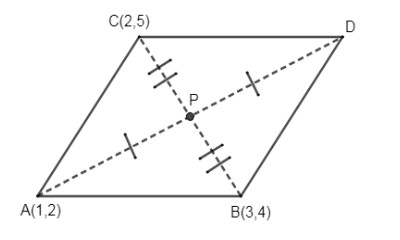Question
Question: If in a parallelogram ABCD, the coordinates of A, B and C are respectively (1, 2), (3, 4) and (2, 5)...
If in a parallelogram ABCD, the coordinates of A, B and C are respectively (1, 2), (3, 4) and (2, 5) then the equation of the diagonal AD is
Solution
Hint:Draw parallelogram ABCD and mark the given points. The diagonals of the parallelogram intersect equal. Thus the point of intersection becomes the mid – point of diagram. Find mid – point using mid – point formula then use two point formula to find equation of diagonal AD.
Complete step-by-step answer:
We have been given a parallelogram ABCD. Along with this we know the coordinates of points A, B and C which are respectively A (1, 2), B (3, 4) and C (2, 5). Now let us draw a parallelogram plotting all these values.

Let AD and BC be the diagonals of the parallelogram. We know that the diagonals of a parallelogram intersect equally. Thus let us mark the point where diagonals AD and BC intersect as P. From the figure you can say that P is the mid – point of the diagonal BC and AD.
Now, by using mid – point theorem, you can get the value of P. As P is the mid – point of BC, we can get the value of P, using the formula,
Mid – point of BC =(2x1+x2,2y1+y2)
Take (x1,y1)=C(2,5) and (x2,y2)=B(3,4).
∴ P = Mid – point of BC = (22+3,25+4)=(25,29)
Thus we got the coordinates of P as (25,29).
Now, we need to find the equation of line AD.
We know the value of 2 points A (1, 2) and P (25,29).
Thus let us use the formula for finding equation of line as,
y2−y1y−y1=x2−x1x−x1
Put (x1,y1)=(1,2) and (x2,y2)=(25,29).
We can rearrange the above formula as,
y−y1=(x2−x1y2−y1)(x−x1)
Now let us substitute the value of (x1,y1) and (x2,y2).
(y−2)=25−129−2(x−1)⇒(y−2)=35(x−1)
Let us cross multiply and simplify it.
